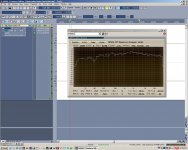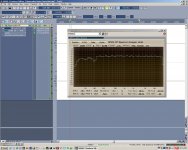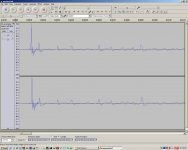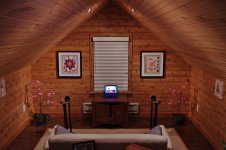Thanks for clarifying. They really are flat. Looking forward to measurements at 1m or listening position.
Cool. Sorry for the confusion. They're good little drivers. More to come later....
If anyone's interested here's the spec sheet for the drivers I'm using...
http://www.parts-express.com/pedocs/specs/295-378-dayton-audio-rs100-4-spec-sheet-revised.pdf
http://www.parts-express.com/pedocs/specs/295-378-dayton-audio-rs100-4-spec-sheet-revised.pdf
Oh, sad I'm not able to be more involved right now, I've been sick with the flu since Friday and I'm just starting to get over it. I do love deciphering data, but my brain isn't up to it right now.
xrk971 and gmad, thank you for taking the data! I'm very interested in how this will go and what can be learned.
A couple thoughts (sorry if I'm off base, brain not working great), I'd love to hear what you guys think. The roll off that starts at 3K, wouldn't that have to do with the size of the driver? If you have about a 4" driver, wouldn't you expect the driver to begin beaming around 3-4KHz? The baffle is so small I would expect the driver diameter to dominate the polar response.
xrk971,
why not try stiffening the back four rombuses (rombi? what's the plural for that?) to try and dampen out the 2.2K resonance? The impulse response from the back is really interesting, stiffening should improve that as well right? Am I reading your 180° plot correctly, the back side sound seems to be dominated by 3rd harmonic distortion? I'm guessing the high distortion is a result of the resonance. Wouldn't 3rd harmonic distortion sound terrible?
sreten,
Your thoughts about the shape are very interesting. If my thoughts in the previous paragraph are right, then the back side resonance is one big fault in this design. It would be almost trivial for me to re-design the shape and make drawings for an a-symmetric version, as long as I can visualize the desired shape. Do you have any more specific suggestions about how the shape of the speaker could be altered?
Lastly, I've been meaning to do some ray tracing in the shape to get an idea of the internal wave propagation, then while looking at the shape it occurred to me that the back side of the speaker comes to a point, similar to the B&W mids and tweeters. They use a teardrop shape to prevent back reflections (at least that's how I understand it). Could that be part of some of the improvements here? If so, what if we took the back for panels and extended them out to get a sharper point? Again, this would be easy for me to design.
xrk971 and gmad, thank you for taking the data! I'm very interested in how this will go and what can be learned.
A couple thoughts (sorry if I'm off base, brain not working great), I'd love to hear what you guys think. The roll off that starts at 3K, wouldn't that have to do with the size of the driver? If you have about a 4" driver, wouldn't you expect the driver to begin beaming around 3-4KHz? The baffle is so small I would expect the driver diameter to dominate the polar response.
xrk971,
why not try stiffening the back four rombuses (rombi? what's the plural for that?) to try and dampen out the 2.2K resonance? The impulse response from the back is really interesting, stiffening should improve that as well right? Am I reading your 180° plot correctly, the back side sound seems to be dominated by 3rd harmonic distortion? I'm guessing the high distortion is a result of the resonance. Wouldn't 3rd harmonic distortion sound terrible?
sreten,
Your thoughts about the shape are very interesting. If my thoughts in the previous paragraph are right, then the back side resonance is one big fault in this design. It would be almost trivial for me to re-design the shape and make drawings for an a-symmetric version, as long as I can visualize the desired shape. Do you have any more specific suggestions about how the shape of the speaker could be altered?
Lastly, I've been meaning to do some ray tracing in the shape to get an idea of the internal wave propagation, then while looking at the shape it occurred to me that the back side of the speaker comes to a point, similar to the B&W mids and tweeters. They use a teardrop shape to prevent back reflections (at least that's how I understand it). Could that be part of some of the improvements here? If so, what if we took the back for panels and extended them out to get a sharper point? Again, this would be easy for me to design.
Thanks for your interest. I've been thinking that the 3k off-axis rolloff relects what is coming off the rear of the driver into the enclosure (I could be wrong). If you'd like I can do a 180 deg measurement with the speaker mounted with the magnet to the outside. Also I'm of the opinion at this point that more stiffness would be better musically than damping.
sreten,
Your thoughts about the shape are very interesting. If my thoughts in the previous paragraph are right, then the back side resonance is one big fault in this design. It would be almost trivial for me to re-design the shape and make drawings for an a-symmetric version, as long as I can visualize the desired shape. Do you have any more specific suggestions about how the shape of the speaker could be altered?
Hi,
I'm not sure its just the back side, its that 8 larger panels are
identical, and for the rear measurement the phases match most.
I realise with a computer 3D co-ordinate model you can move
the vertices around, for a much more complicated cutting list,
with various edge lengths and edge angles, harder to build.
Also note its just a simple assumption / approximation
on my part, I don't know exactly what really going on.
What I do know about resonances in the critical area
of the midband is that first impressions are an highly
unreliable arbiter of long term listening satisfaction,
and the more striking the initial effect the less likely
it will be deemed to be acceptable in the long run.
You get a false "halo" effect until your ear and brain
catch up with what is actually going on and then
they get bored and annoyed with the effect is the
best way I can surmise my experiences/opinion.
rgds, sreten.
A friend fitted a new aluminium armboard to
his turntable, touted as "very dynamic". It
certainly brought out the snare drum "crack".
However I was dubious, (who me ?). Turning
off the audio and simply listening to the table
playing a record you could hear the armboard
tinkling away (it was attached by two spacers).
YMMV but in my book that is simply wrong.
Further listening indicated it made snare drums
sound more similar, and when I replaced the
spacers with the original MDF armboard the effect
became very clear, snare drums sounded more
different again, a more accurate reproduction.
Last edited:
sreten,
Wow, your observations about first impressions vs. long term listening fits right in line with what John Krutke of Zaph Audio says. He attributes it more to harmonic distortion, but as some of xrk971's measurements show, there's a lot of harmonic distortion coming from the enclosure. It would be interesting to check back in with xrk971 after a month or so of listening to the speakers he built.
If I designed an asymmetric enclosure, you're right, it would be much harder to build. Every panel would be unique. So I guess the question is, would anyone be interested in that? Seems to me some people on this forum have done crazier things.
Wow, your observations about first impressions vs. long term listening fits right in line with what John Krutke of Zaph Audio says. He attributes it more to harmonic distortion, but as some of xrk971's measurements show, there's a lot of harmonic distortion coming from the enclosure. It would be interesting to check back in with xrk971 after a month or so of listening to the speakers he built.
If I designed an asymmetric enclosure, you're right, it would be much harder to build. Every panel would be unique. So I guess the question is, would anyone be interested in that? Seems to me some people on this forum have done crazier things.
sreten,
Wow, your observations about first impressions vs. long term listening fits right in line with what John Krutke of Zaph Audio says. He attributes it more to harmonic distortion, but as some of xrk971's measurements show, there's a lot of harmonic distortion coming from the enclosure. It would be interesting to check back in with xrk971 after a month or so of listening to the speakers he built.
If I designed an asymmetric enclosure, you're right, it would be much harder to build. Every panel would be unique. So I guess the question is, would anyone be interested in that? Seems to me some people on this forum have done crazier things.
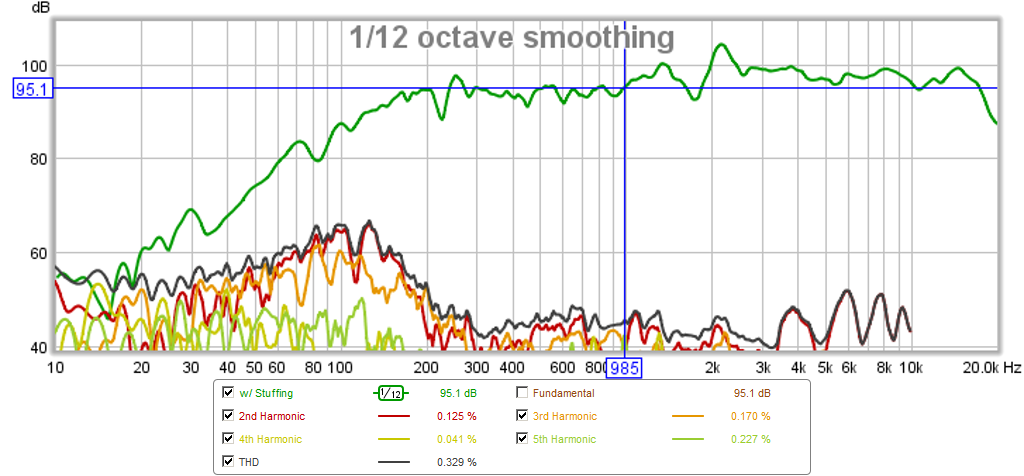
The HD on axis from the front where the direct radiator is actually quite low - less than 1% above 300Hz. The re-radiated emission from the back at 180deg is higher in HD, but that doesn't reach the front given the measured data above.
I might try adding some mass via latex caulking and a second layer on four of the rear rhomboids.
Note that the impulse response from the front on-axis is excellent and has virtually none of the ringing that is apparent from the 180deg data. This is almost an ideal impulse response, and you can imagine has a very good looking step response.
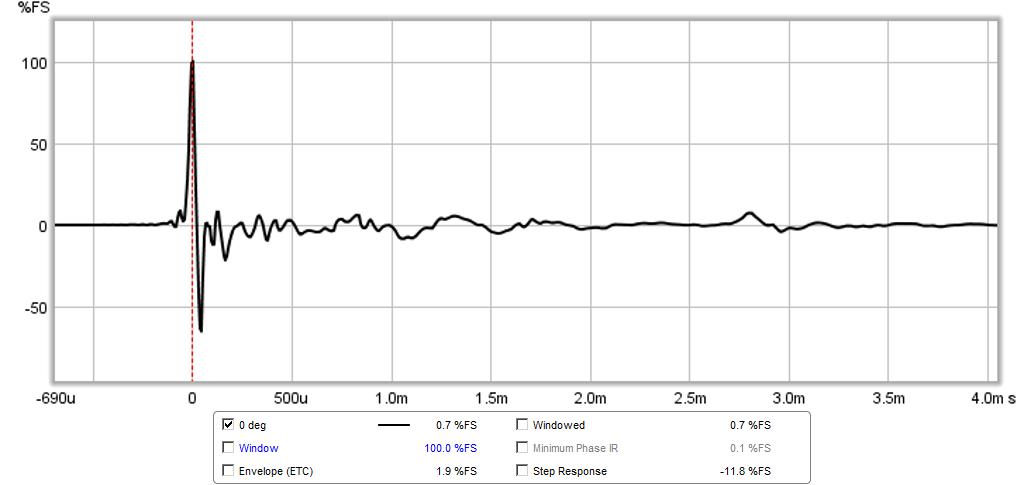
Last edited:
Hi,
So the the direct field is pretty good, very good,
but what can you assume from that, given all
the other evidence you have ?
rgds, sreten.
So the the direct field is pretty good, very good,
but what can you assume from that, given all
the other evidence you have ?
rgds, sreten.
Hypercube in phase harmonics are not a distotion!
I think we need to stop thinking about the Hypercube as a conventional loudspeaker / driver cabinet combo....I suggest thinking about it more as a musical instrument.....
If we were to install a violin or Cello in an large infinite baffle and measure it the way we measure a loudspeaker there would be a "pure" note measured off the strings and (behind the infinite baffle) lots of "harmonics" being radiated by the wooden panels and backboard.....
Important point here, these harmonics are in phase and radiated with a broad and even power response in 360 degrees / 3D space.
We do not criticise violins for radiating harmonics, or call them a "distortion", they are not distortions they are the "tone & character of the instrument....This is the way the instrument is designed to work!
I suspect the Hypercubes unique ability to radiate harmonics in phase in a similar fashion is what makes it sound so natural and enjoyable.
I believe until someone has measured the Hypercube under strictly controlled conditions and tested various cabinet materials (ie compare damped foam core with floppy hot melt glue joints Vs rigid acrylic / polymer with cold weld liquid acrylic glue) it would be a mistake to start experimenting with asymmetric cabinet materials ( a very effective technique with conventional loudspeaker cabinets) as this will radically alter the Hypercubes performance.
Normally asymmetry is our friend, rooms designs, subwoofers positioning, internal cabinet shapes etc....
I believe the all of the Hypercubes panels act as an extension of the loudspeaker driver cone , ie its radiation is in phase with the main cone output....Therefore to "break up" the Hypercubes driver surface with different materials would be a mistake....
Having never heard a Hypercube (yet!) I am only speculating, but the logic of the Hypercube has captured my imagination!
Cheers
Derek.
""..... there's a lot of harmonic distortion coming from the enclosure...."
" If I designed an asymmetric enclosure, you're right, it would be much harder to build. Every panel would be unique.
I think we need to stop thinking about the Hypercube as a conventional loudspeaker / driver cabinet combo....I suggest thinking about it more as a musical instrument.....
If we were to install a violin or Cello in an large infinite baffle and measure it the way we measure a loudspeaker there would be a "pure" note measured off the strings and (behind the infinite baffle) lots of "harmonics" being radiated by the wooden panels and backboard.....
Important point here, these harmonics are in phase and radiated with a broad and even power response in 360 degrees / 3D space.
We do not criticise violins for radiating harmonics, or call them a "distortion", they are not distortions they are the "tone & character of the instrument....This is the way the instrument is designed to work!
I suspect the Hypercubes unique ability to radiate harmonics in phase in a similar fashion is what makes it sound so natural and enjoyable.
I believe until someone has measured the Hypercube under strictly controlled conditions and tested various cabinet materials (ie compare damped foam core with floppy hot melt glue joints Vs rigid acrylic / polymer with cold weld liquid acrylic glue) it would be a mistake to start experimenting with asymmetric cabinet materials ( a very effective technique with conventional loudspeaker cabinets) as this will radically alter the Hypercubes performance.
Normally asymmetry is our friend, rooms designs, subwoofers positioning, internal cabinet shapes etc....
I believe the all of the Hypercubes panels act as an extension of the loudspeaker driver cone , ie its radiation is in phase with the main cone output....Therefore to "break up" the Hypercubes driver surface with different materials would be a mistake....
Having never heard a Hypercube (yet!) I am only speculating, but the logic of the Hypercube has captured my imagination!
Cheers
Derek.
Overkill:
I've really enjoyed your posts so far. I'm glad you're part of this.
Muddjester:
Sorry about the "hurried" nature of my post before....I was between classes at school. I hope my point got across about driver rear-radiation having subdued high frequencies. I hope you feel better soon as I for one appreciate having your brain involved in all of this (as well as your software lol).
I've really enjoyed your posts so far. I'm glad you're part of this.
Muddjester:
Sorry about the "hurried" nature of my post before....I was between classes at school. I hope my point got across about driver rear-radiation having subdued high frequencies. I hope you feel better soon as I for one appreciate having your brain involved in all of this (as well as your software lol).
xrk971:
I've attached (crude) screenshots of measurements taken from my listening spot (a distance of 5') showing impulse response and frequency response of the hypercubes with and without the small amount of correction I use while listening. Also attached is a photo to tell a little bit about the room since it's definitely a factor in these measurements.
I've attached (crude) screenshots of measurements taken from my listening spot (a distance of 5') showing impulse response and frequency response of the hypercubes with and without the small amount of correction I use while listening. Also attached is a photo to tell a little bit about the room since it's definitely a factor in these measurements.
Attachments
Nice, I like how you are keeping it completely symmetrical.
Japanophile? ;-) Goes well with origami speakers.
Is there a sub?
Japanophile? ;-) Goes well with origami speakers.
Is there a sub?
Last edited:
Nice, I like how you are keeping it completely symmetrical.
Japanophile? ;-)
Is there a sub?
Thanks! no sub...
"
these harmonics are in phase and radiated with a broad and even power response in 360 degrees / 3D space.
Derek.
Hi,
Nonsense. Try making a solid violin. Like a solid guitar output
is pathetic but sustain is great. There is no phase relation
between the string and the bodies output,* the output
is the body and and largely the top in a violin and a
guitar which by definition will largely be coherent.
Its certainly not omnidirectional as anyone who mikes
one up will tell you. The sides and back largely define
the interior resonant cavity fed from the top plate
and that bleeds lower frequencies out through
the front sound holes, again not omnidirectional.
Your musings are in all respects wishful conjecture
that ignores all the basic physics of the situation,
and lend no insight or understanding of anything.
rgds, sreten.
* Other than its the mechanical variation of the string tension
on the bridge which is driving the topplate, and the more the
bridge and topplate move under the variable tension, i.e. the
louder the acoustic sound the less the sustain of the note.
Less noticable with an electric violin than a electric guitar
because a violin doesn't have frets, so the fingers damp
the strings mechanical vibration much more.
Last edited:
How can you live with that little bass?
I'm not interested in more bass unless it's hypercube bass! one day....
Hello again.
I admit that I myself have been tempted to think of these speakers as more like old school musical instruments. But it is proper to be cautious about such generalizations. My own preference is for thinner wood, but there are many who (as I think Cal mentioned) equate more thickly built structures with higher quality. I have never encountered a situation in which loud transients damaged the thinner enclosures, but to be fair, I was actively trying to accomplish that either.
Until we have detailed testing on different wall thicknesses it seems premature to presume that we have found an optimum that will satisfy the majority of listeners. There is an irreducible amount of subjectivity in listening experiences, and room for all tastes.
It seems true to me that thicker structures will reduce panel vibrations, and conversely, that insufficiently rigid walls could lead to undesirable amounts of egregious resonances.
Having said that, I can only offer my own experiences with this design, which seem to indicate that the bass purity and transient response at zero degrees seem be less dependent upon wall thickness, and the secondary radiation from the panels somewhat more dependent. I can imagine situations where a more directional response is desired, which would require thicker enclosures.
When we demonstrated this design at Pier 6 Pavilion in Baltimore, it seemed that far fewer units were required for coverage of the seating area, which had less reverberation than the typical indoor venue because it is located on the waterfront of the Baltimore inner harbor and actually has no side walls to contain the acoustic energy. The existing installation involved numerous JBL units and we were achieving comparable coverage with a single pair of 12 inch Radian coaxials mounted in our cabinets on the stage. I regret that no detailed data were obtained that day, making this again merely anecdotal.
There were no criticisms or complaints presented by the listeners, but I was told that pre-existing contractual obligations precluded their using our design at this venue.
I admit that I myself have been tempted to think of these speakers as more like old school musical instruments. But it is proper to be cautious about such generalizations. My own preference is for thinner wood, but there are many who (as I think Cal mentioned) equate more thickly built structures with higher quality. I have never encountered a situation in which loud transients damaged the thinner enclosures, but to be fair, I was actively trying to accomplish that either.
Until we have detailed testing on different wall thicknesses it seems premature to presume that we have found an optimum that will satisfy the majority of listeners. There is an irreducible amount of subjectivity in listening experiences, and room for all tastes.
It seems true to me that thicker structures will reduce panel vibrations, and conversely, that insufficiently rigid walls could lead to undesirable amounts of egregious resonances.
Having said that, I can only offer my own experiences with this design, which seem to indicate that the bass purity and transient response at zero degrees seem be less dependent upon wall thickness, and the secondary radiation from the panels somewhat more dependent. I can imagine situations where a more directional response is desired, which would require thicker enclosures.
When we demonstrated this design at Pier 6 Pavilion in Baltimore, it seemed that far fewer units were required for coverage of the seating area, which had less reverberation than the typical indoor venue because it is located on the waterfront of the Baltimore inner harbor and actually has no side walls to contain the acoustic energy. The existing installation involved numerous JBL units and we were achieving comparable coverage with a single pair of 12 inch Radian coaxials mounted in our cabinets on the stage. I regret that no detailed data were obtained that day, making this again merely anecdotal.
There were no criticisms or complaints presented by the listeners, but I was told that pre-existing contractual obligations precluded their using our design at this venue.
Hello again.
I have never encountered a situation in which loud transients damaged the thinner enclosures, but to be fair, I was actively trying to accomplish that either.
Groan. Sorry, type: I was not actively trying to accomplish that either.
- Status
- Not open for further replies.
- Home
- Loudspeakers
- Full Range
- Hypercube Loudspeakers
